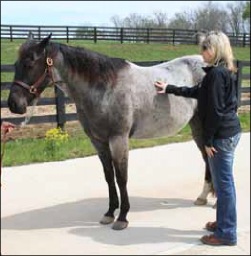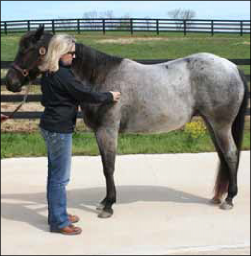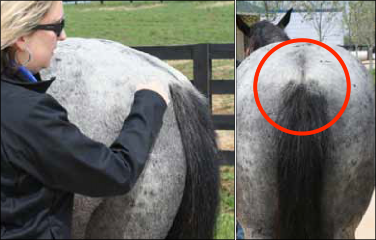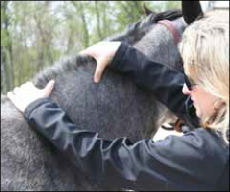Help! My Horse is Too Fat!
Help! My Horse is Too Fat!
Authors: Fernanda Camargo, Laurie Lawrence, and Bob Coleman, Department of Animal and Food Sciences
As we understand more about the impact that obesity and emaciation have on animal health, it is imperative that we strive to keep our horses at an optimum body condition.
Since 1983, a procedure developed by Dr. Don Henneke has served to provide a standard body condition scoring system that can be used across breeds and by all horse people. The system assigns a numerical score—one through nine—based on the amount of fat that has accumulated in the important areas used to assess the body condition of horses.
Body Condition Scoring System
The Henneke system assesses accumulated fat both visually and by palpation in each of six areas: ribs, behind the shoulder, withers, loin, tailhead, and neck. A numerical value is assigned based on the fat accumulated in all six areas (Table 1).
| Table 1. Henneke Body Condition Scoring System. | ||||||
| Condition | Ribs | Neck | Withers | Loin | Tailhead | Shoulder |
| 1: Poor |
Tailhead (pinbone) |
Bone structure easily |
Bone structure |
Spinous processes |
Spinous processes |
Bone structure |
| 2: Very Thin |
Slight fat cover |
Faintly discernible; |
Faintly discernible |
Slight fat covering |
Tailhead prominent | Shoulder accentuated |
| 3: Thin |
Slight fat cover |
Neck accentuated | Withers accentuate |
Fat buildup halfway |
Tailhead prominent |
Shoulder accentuated |
| 4: Moderately Thin | Faint outline discernible | Neck not obviously thin | Withers not obviously thin | Negative crease along back | Prominence depends on conformation; fat can be felt; hook bones not discernible | Shoulder not obviously thin |
| 5: Moderate | Ribs cannot be visually distinguished, but can be easily felt | Neck blends smoothly into body | Withers rounded over spinous process | Back level | Fat around tailhead beginning to feel spongy | Shoulder blends smoothly into body |
| 6: Moderately Fleshy | Fat over ribs feels spongy | Fat beginning to be deposited | Fat beginning to be deposited | May have slight positive crease down back | Fat around tailhead feels soft | Fat beginning to be deposited |
| 7: Fleshy |
Individual ribs can |
Fat deposited along |
Fat deposited |
May have positive |
Fat around tailhead |
Fat deposited |
| 8: Fat | Difficult to feel ribs |
Noticeable thickening |
Area along withers |
Positive crease down |
Tailhead fat very soft |
Area behind |
| 9: Extremely Fat |
Patchy fat appearing |
Bulging fat; fat along |
Bulging fat |
Obvious positive |
Building fat around |
Bulging fat |
| Adapted from Henneke et al. Equine Vet J. (1983) 15 (4), 371-372 |
 Ribs. The first place to look when assessing the body condition score (BCS) of a horse is in the ribcage. If ribs are easily seen, the horse will have a score over the ribcage below a 5. If you cannot see the ribs, then the score should be a 5 or above. During winter and spring it might be difficult to see ribs because of the horse’s coat, so it is always important to run your fingers across the ribcage to assign the correct score. A very thin horse will have prominent ribs—easily seen and felt—with no fat padding. As the horse gains weight and body condition, a little padding can be felt around the ribs. By score 5, the ribs will no longer be visible, but can be easily felt. Once the body condition score is above 7, the ribs become more difficult to feel.
Ribs. The first place to look when assessing the body condition score (BCS) of a horse is in the ribcage. If ribs are easily seen, the horse will have a score over the ribcage below a 5. If you cannot see the ribs, then the score should be a 5 or above. During winter and spring it might be difficult to see ribs because of the horse’s coat, so it is always important to run your fingers across the ribcage to assign the correct score. A very thin horse will have prominent ribs—easily seen and felt—with no fat padding. As the horse gains weight and body condition, a little padding can be felt around the ribs. By score 5, the ribs will no longer be visible, but can be easily felt. Once the body condition score is above 7, the ribs become more difficult to feel.

Shoulder. A BCS of 5 means the shoulder blends smoothly with the body. At increasing condition scores, fat is deposited behind the shoulder and becomes bulging. This observation is especially true in the region behind the elbow. The shoulder bony structures will become more visible
as the scores drop below 5.

Withers. If a horse is very thin, no fat will be deposited between the top of the shoulder blade and the spinal vertebrae, making the two structures easily discernible. As the horse’s condition score
increases, fat fills in between the top of the shoulder blade and spinal vertebrae; so at a condition score of 5, the withers will appear rounded. As horses approach the high end of the condition scoring scale, the withers will be bulging with fat.

Loin. The loin is the area of the back just behind where the saddle sits. At a condition score of 5, the loin area will be relatively level—the spine is not sticking up, nor is there a dent or crease along the spine. At condition scores below 5, the spine starts to become prominent; this is sometimes called a “negative crease.” An extremely thin horse will have a definite ridge down the back where the vertebrae of the spine become obvious. As the condition score increases above a 5, fat begins to build up on either side of the spine and a visible crease starts to appear.

Tailhead. In a very thin horse, the tailhead is prominent and easily discernible. Once the horse starts gaining weight, fat fills in around the tailhead. As the condition score exceeds 7, the fat will feel soft and begin to bulge
 Neck. In a very thin horse, you might be able to see the bone structure of the neck. As the horse gains condition, fat will be deposited on the top of the neck. At a condition score of 5, the neck blends smoothly into the body. Body condition scores of 8 and 9 are characterized by a neck that is
Neck. In a very thin horse, you might be able to see the bone structure of the neck. As the horse gains condition, fat will be deposited on the top of the neck. At a condition score of 5, the neck blends smoothly into the body. Body condition scores of 8 and 9 are characterized by a neck that is
thick all around with fat evident at the crest.
Overall Score
After each area is assessed and assigned a score (not all horses will get the same score at each location) you can average all the scores to get to a final overall score. For example, a horse might score 6 on some areas and 7 on others. For research purposes, the overall score can have decimal numbers, but for practical purposes, most people would record a value of 6+ or 7-.

Putting the System to Work
Horses can perform almost every activity at a BCS of 5. Most athletic horses are kept at a 5, sometimes 6, depending on their discipline. Some equine athletes, such as endurance horses, will have condition scores between 4 and 5. However, keeping broodmares at condition scores below 5 may reduce their reproductive efficiency. In addition, horses with condition scores below 5 may lack the fat stores necessary to withstand a cold winter or other stressful situations. On the other hand, horses that have condition scores above 6 may be less exercise tolerant than their trimmer counterparts and very fat horses may put extra stress on bones, joints, and hooves. Horse owners should regularly condition score their horses to determine whether a change in body condition would be desirable.
Reducing Body Condition in Fat Horses
Follow these tips if you have a horse that is too fat:
Be patient: Depending on how fat your horse is, it may take several months to arrive at his target weight and condition score. Look for small steady changes and don’t be surprised if after some initial
improvements, your horse appears to plateau. If that happens, revisit the feeding program and the exercise program and evaluate whether additional changes are necessary.
Think about calories first: A mature horse will lose weight and condition when the number of calories it consumes is less than the number of calories it uses. Therefore to decrease body condition the horse must either decrease calorie intake, or increase calorie use (or both). It isn’t
healthy to starve a horse into weight loss, so a combination of increased calorie use and decreased calorie intake is a good approach.
Understand where calories come from: The horse consumes calories from its pasture, hay and concentrate feed (such as a sweet feed). Most people underestimate the importance of hay and pasture in the horse’s diet. If hay and pasture are good quality and abundant, they can contribute
the majority of the calories that a horse needs! The fiber in hay and pasture is also important to keep the digestive tract healthy. Concentrates have the most calories per pound. Therefore the first step in reducing the calorie intake of fat horses is to decrease the concentrate. Also, do not add any fat to the diet! Fat is high in calories and although it helps have a shiny coat, it is a source of calories
that a fat horse doesn’t need!
Dealing with feeding-time frenzy: Some horses become extremely agitated when other horses get concentrate and they don’t. To minimize this frenzy, feed a fat horse a small amount (one eight-ounce cup) of a high-protein, high-mineral supplement (often referred to a balancer pellet or a supplement pellet) at the same time the other horses get their regular concentrate. This small amount of food will help appease the fat horse and it will meet its needs for protein, vitamins
and minerals not provided by the hay. Another option for feeding-time frenzy is to purchase some hay cubes or hay pellets and feed a small amount (again less than a pound). This is a good appeasement strategy but doesn’t provide the same nutrient support as the balancer pellet.
Generally, these feeds will be less palatable than concentrate, and it may take the horse a few days to adapt, but most horses eventually do!
Restrict pasture access: Lush pasture can provide almost an unending source of calories for your horse, as you can’t control the amount of grass the horse is ingesting per day. The best way to reduce pasture intake is to put the horse in a dry lot (sacrifice lot) where you will be able to control the amount of food your horse will have access to. This is, of course, only feasible, if there is space in your property for a dry lot. Confining a horse to a dry lot may decrease his level of activity, which
will, in turn, reduce the number of calories he uses each day. Consider using a young horse as a companion to keep the fat horse moving. You just need to ensure that the horses get along so no one gets hurt. Remember to feed the youngster separately, as he will need a diet designed to meet his needs.
Grazing muzzles: Another way to restrict pasture intake is to use a grazing muzzle (shown in Figure 13). Some horses will adapt very well to the muzzle, while others will sulk. Muzzles allow horses to eat very little at a time, and the horse will not be by himself in a dry lot. Pasture mates will keep that horse moving all day. Just be careful to fit the muzzle correctly so it doesn’t cause any facial sores. Also, when horses are muzzled, your water source is important. Some automatic waterers have openings that are small, in which case it will be impossible for your muzzled horse to drink sufficient amounts of water. If you are watering out of a bucket or trough, then you should have no trouble. One other thing to keep in mind when muzzling horses is that it is useless to muzzle a horse, say, for 6 hours of the day, and let him eat for the remaining 18 hours. He will make up for those lost 6 hours in the other 18 hours. You should keep the muzzle on whenever the horse is in the pasture.
Feed clean, late maturity grass hay: Hay will be primary diet component of horses managed in a dry lot, in a barn or in a large paddock with minimal available pasture. Fat horses should be fed hay that was harvested in late maturity. Late maturity grass hay (for example timothy or orchardgrass) is high in slowly digested fiber and thus is lower in calories than early maturity hay. In addition, because late maturity hay is higher in fiber, the stems are thicker, and it takes the horse more time to chew. More chewing time means that horse has less idle time between meals; and, chewing uses calories! If you get your hay analyzed, look for something that contains more than 60 percent neutral detergent fiber (on an as fed basis).
Control the amount of hay: Some feeding guidelines suggest that a horse should receive 2 pounds of hay for every 100 pounds of body weight (or 20 pounds of hay for a 1000-pound horse). That is a pretty good guideline for a horse in moderate body condition, but for the very fat horse, it is probably more than is needed. Keep in mind that a horse with a condition score of 8 and a current weight of 1000 pounds will be an 850-900 pound horse with a lot of extra padding. A reasonable starting point then for a weightloss hay allocation for that horse would be 2 pounds of hay for each 100 pounds of the target weight, or about 17 pounds of hay per day. If no weight loss occurs at this rate of feeding then, the amount can be slowly decreased. However, restricting hay too much might lead to digestive disorders or undesirable behaviors, so it is desirable to maintain a hay intake of at least 1½ pounds for each 100 pounds of the target weight.
Find ways to help your horse burn more calories: As suggested above, putting a young active horse with a sedentary fat horse may stimulate him to move around more. Turning stabled horses into dry lots for several hours a day can increase their activity. In a paddock, put hay and water away from fence lines, gates, resting places (and each other) to encourage movement. Use feeding devices or practices that slow the rate of eating or increase the work of eating. For example, there are hay nets with small holes; or when feeding hay in the pasture, putting it in many small piles will make the horse move from place to place. If you normally blanket your horse in the winter, or keep him in the barn a lot, you are helping him reduce calorie use. So, minimize blankets and time in a barn as much as possible, to maximize calorie use in the winter.
Exercise: Regular exercise is one of the best ways to increase calorie use. But before starting an ambitious exercise program, have a veterinarian and a farrier evaluate your fat horse to make certain he doesn’t have any underlying diseases or lameness. Once you are sure the horse is healthy and able to start exercising, formulate a plan that gradually increases the amount and difficulty of the regular exercise. You can start with lunging exercise, for example, 10 minutes a day at a trot for a week, then increase to 15 minutes at a trot for the second week, and progressively increase the duration until you reach about 45 minutes at least a few times a week. Remember to increase the duration or level of activity, but never both at the same time. Ideally it would be good to exercise a horse every day, but if this is not feasible, exercising 3 to 5 times a week will still be helpful.
For More Information
If your horse is too thin and needs to gain weight and condition, see “Help! My Horse is Too Thin” (ASC-188).
